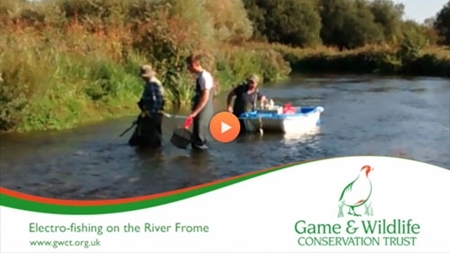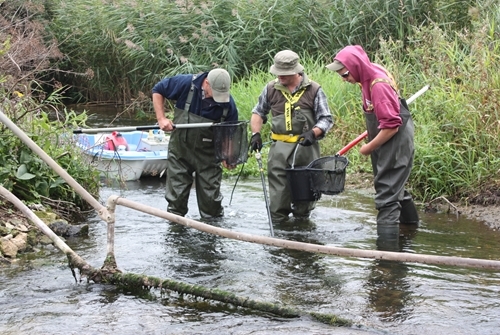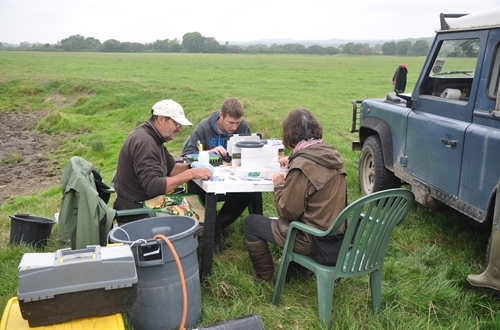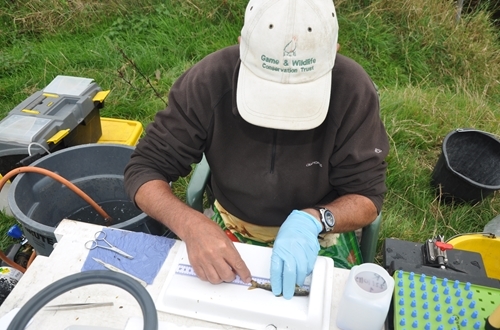Each September, our fisheries team catch, weigh, measure and tag over 10,000 salmon parr. A process called electro-fishing, in which an electric current is used to stun the fish so that they can be caught in nets, is what makes this huge endeavour possible. The tagging of a significant proportion of the autumn parr population is a key component of our ability to estimate numbers of parr and smolts, and adult marine survival.
Video: GWCT scientists and students electro-fishing on the River Frome

The scientists, assisted by students who come to help and gain practical experience, catch the young fish by putting an electric field, created by a generator situated in a small boat pulled along behind, into the water so that the fish are temporarily incapacitated and thereby easier to catch in a net. It requires quick reactions as the fish are dazed for just a few seconds, as demonstrated by the captured fish, which are swimming around in the bucket quite normally almost immediately after they are put in.
 Dylan Roberts (GWCT Head of Fisheries), Eddie Hopkins (Bournemouth University) and
Dylan Roberts (GWCT Head of Fisheries), Eddie Hopkins (Bournemouth University) and
Luke Gwilliam (Bridgwater College) electro-fishing on the Frome in September 2014
Meanwhile, on the bank, a mobile laboratory has been set up to process the fish caught. They are weighed and their length is measured and recorded. Then they are tagged using small (12x2mm) passive integrated transponder (PIT) tags. The use of PIT tags inserted inside the body cavity is widely established as a relatively benign method of tagging and identifying individual fish, and the method has been used successfully in a number of studies of wild salmon parr populations both in the UK and abroad.

The mobile lab, where parr are measured, weighed and tagged
Trials of the tagging began in 2002, and from 2006 onward approximately 10,000 individual parr per year have been tagged throughout the catchment. From previous estimates of the total Frome parr population, this represents about 15-20% of the total late autumn salmon parr population.

Senior Fisheries Scientist Bill Beaumont measuring a parr before tagging
The passage of the tagged fish out to sea is recorded by equipment mounted on the East Stoke smolt counter, the main river weir at East Stoke, the Tadnoll Brook tributary and the Environment Agency fish pass at Louds Mill, Dorchester. The main river reader at East Stoke and Louds Mill also allows the detection of the return of the PIT-tagged adult fish.
One of our tagged parr from the Frome was recorded swimming past the GWCT detection equipment on the night of 24 April 2008 on its way out to sea and was estimated to be about 14.9cm long. On 6 October 2009, the same fish was picked up during a sampling programme organised by the North Atlantic Salmon Conservation Organisation (NASCO) in Sisimiut on the west coast of Greenland, by which time it had grown to 67.9cm.
The use of PIT tags, and the ability to identify and follow individual fish through their complete life cycle, enables reproductive success, smolt production and subsequent adult survival to be monitored. This includes the ability to assess riverine and marine survival from different habitat types and site/tributary origin of parr. These records, together with the records from the PIT reader on the Louds Mill weir at Dorchester, give us unparalleled information about marine survival rates.